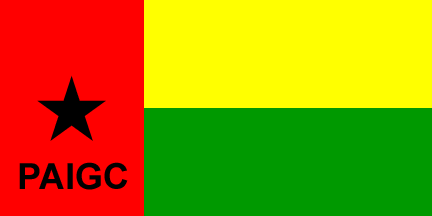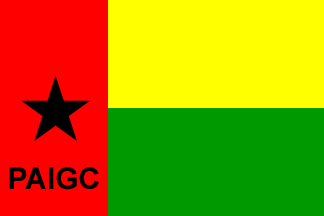
image by Jorge Candeias, 27 Mar 2010

Last modified: 2017-11-25 by antónio martins
Keywords: paigc | p.a.i.g.c. | star: 5 points (black) | pan-african | african party for the independence of guinea and cape verde | partido africano da independência da guiné e cabo verde |
Links: FOTW homepage |
search |
disclaimer and copyright |
write us |
mirrors

image by Jorge Candeias, 27 Mar 2010
See also:
Other sites:
Recently, after the civil war that torn the country apart, the Guinean governmental party P.A.I.G.C. (Partido Africano da Independência da Guiné e Cabo-Verde — I think this is still its name) held a convention to decide on its future. The decisions aren’t interesting for us (except that the party continues and keeps the same symbols), but the flag is. This flag was hanging from the table of the convention presidency (a common practice in Portugal also), so I suppose that it as official as one can get. The source for this are TV images.
The flag is just the national flag in a proportion of 1:2 with the sigla of the party beneath the black star, also in black.
This party flag is particularly important because it gave birth to not one but two national flags: that of Guinea-Bissau and the old national flag of Cape Verde. The Cape-Verdean party PAICV, that nowadays has a different flag, used also a flag in these lines. The reason for this is that Guinea-Bissau and Cape Verde constituted a short-lived confederacy after independence under the leadership of the P.A.I.G.C., a party that had Cape-Verdian and Guinean membership and was winning the war against the Portuguese colonial forces in Guinea-Bissau by the time of the Portuguese revolution in 1974.
The union broke apart because there were conflicts between the Cape-Verdians (with a much more European culture — Cape Verde is basically a mixed country, racially, culturally, linguistically, etc.) and the Guineans (who in the vast majority didn’t speak Portuguese) inside the party, that immediately were reflected at state level. The symbols, however, remained very close until the democratization of Cape Verde and the consequent change of national symbols in this country.
The symbolism of this flag is just like that of the national flag and inherited from the symbolism of Ghana, from which it comes: an arrangement of the pan-African colours with the black star of Africa added.
Jorge Candeias, 02 Nov 1999
P.A.I.G.C. was defeated in latest elections. Following that was issued
in Cabo Verde can we expect a flag change?
Jaume Ollé, 26 Jan 2000
Maybe, but the recent role and style of the P.A.I.G.C. in Guinea-Bissau
was not at all like the P.A.I.C.V. in Cape
Verde in 1992. And the Cape Verde flag was
changed mostly because it looked too much like the flag of
Guinea-Bissau, not because it looked like the
P.A.I.C.V. flag (which in turn was also changed somewhen later).
António Martins, 27 Jan 2000

image by Jorge Candeias and António Martins,
27 Mar 2010
The flag of P.A.I.G.C. is shown in both ballot papers reported, #1 in
both Bissau-28 and Bissau-29, in 2:3 ratio (which
is not the “default” ratio most flags were procrusted to in
these sources) with slightly smaller text size.
António Martins, 27 Mar 2010
This photo appeared in Público (Portugal) newspaper, without caption, illustrating an article about the elections held there last March. Later, the same photo illustrated another article on the same subject, but now with a caption identifying the demonstrators as P.A.I.G.C. supporters.
So, it’s related with the P.A.I.G.C. but it is not the flag of the party, unless it changed flags recently without telling us. The flag is plain with a very large symbol occupying almost its entire surface, with includes a rising sun and the portrait of Amílcar Cabral, the national hero and former leader of P.A.I.G.C.
Speculating a bit, the fact that most of the people in the photo is young may mean that the flag might belong to some sort of youth organization.
Jorge Candeias, 27 Nov 2004
I have a photo from the independence war where the flag with Cabral
image were already used. Issued in magazine Afrique-Asie.
Jaume Ollé, 30 Apr 2003
Anything below this line was not added by the editor of this page.